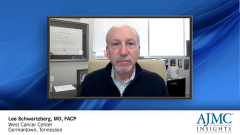
Chemotherapy-Induced Neutropenia: Financial Burden
A payer remarks on the costs of chemotherapy-induced neutropenia (CIN) on the health system and shares thoughts on the utilization of newer therapies and delivery of CIN prophylaxis to appropriate patients.
Episodes in this series

John Fox, MD, MHA: Our biggest concern with febrile neutropenia in our members is simply that if that occurs, it not only results in a costly hospitalization, but it also results in delay in their treatment and maybe even a change in their treatment. But probably even more concerning about that is the high cost of preventing hospitalization. If you look at the pivotal trials that were completed to demonstrate the efficacy of pegfilgrastim, for example, it showed that in patients given docetaxel in adjuvant treatment for breast cancer, that they could reduce the hospitalization rate from 16% to 1%, and reduce the risk of febrile neutropenia from 14% to 1%. There are very high effectiveness rates, but that translates into 6 or 7 patients needed to have prophylaxis for febrile neutropenia to prevent 1 hospitalization. Part of my job is to look at costs. Even in the best-case scenario, pegfilgrastim might cost $3500 a dose, and that’s generous. In an adjuvant setting, or neoadjuvant setting, or a presurgical setting, that’s 4 doses of pegfilgrastim at $3500 each. So $14,000 for 4 cycles with pegfilgrastim, compared to the cost of a hospitalization—which is approximately, last year Medicare’s base rate was $5800—so we’re spending $14,000 to prevent a $6000 or $7000 admission.
And then, we must treat 6 or 7 patients in order to prevent 1 additional hospitalization, so the cost is high. I would say that certainly, as a payer, we’re trying to ensure that the right patients get treatment with pegfilgrastim to make sure that the patients most likely to need it, benefit from it, but to limit it to those who are most in need.
Clearly, prophylaxis against CIN [chemotherapy-induced neutropenia] and febrile neutropenia adds to the total cost of care, but notably in several analyses that have been done, this is done in a cost-effective manner. It doesn’t save costs, but it can be delivered in a cost-effective manner. In lymphoma, in a number of publications it has been shown that the therapy can be delivered at less than $50,000 per quality-adjusted life year, and for breast cancer, CIN prophylaxis has been shown to come in under 30,000 euros. In both these circumstances, in lymphoma and in breast cancer, while not cost saving, CIN prophylaxis can be done cost effectively.
Newsletter
Stay ahead of policy, cost, and value—subscribe to AJMC for expert insights at the intersection of clinical care and health economics.





































